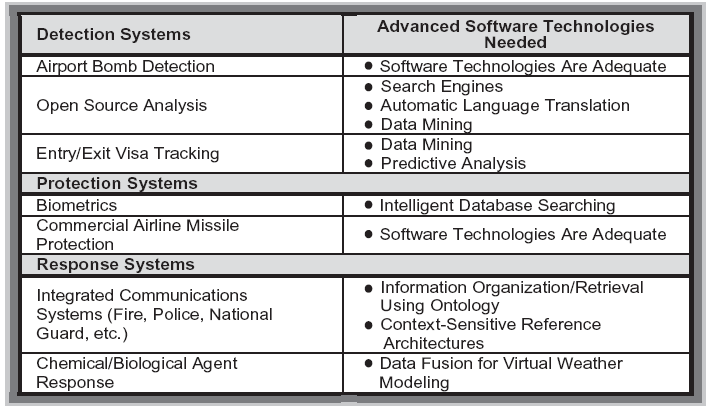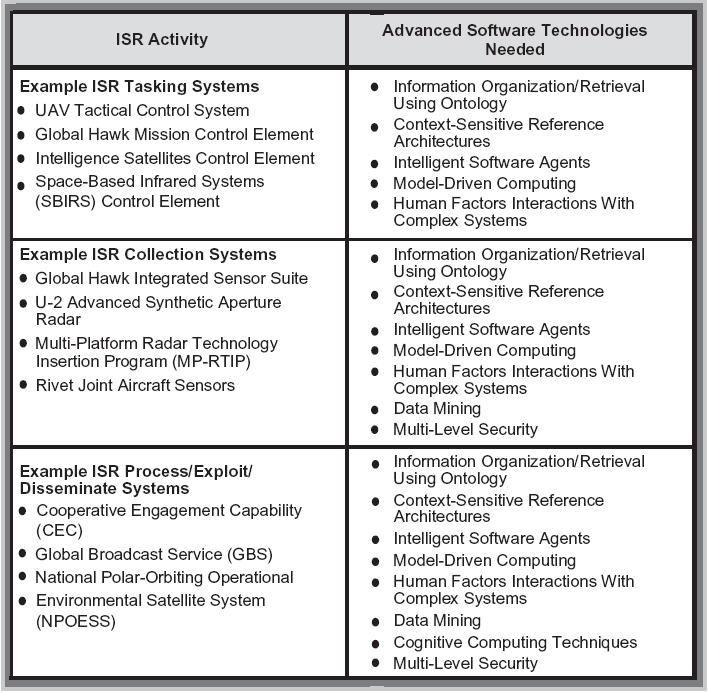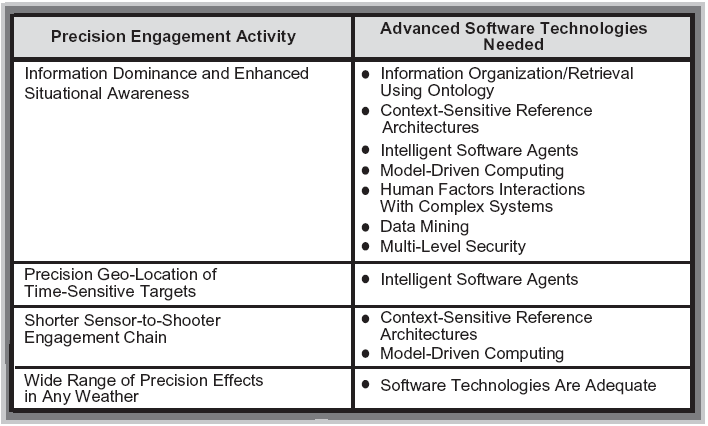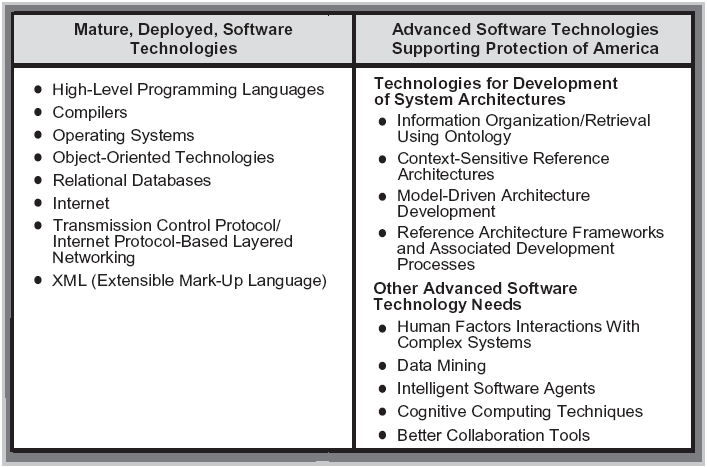Advanced Software Technologies for Protecting America
Gregory S. Shelton, Raytheon Company
Randy Case, Raytheon Company
Louis P. DiPalma, Raytheon Company
Dan Nash, Raytheon Company
Advanced software technologies are required for the success of homeland security, missile
defense, intelligence/surveillance/reconnaissance, and precision engagement. Stateof-
the-art software technologies for system architecture development such as model-driven
computing, reference architectures, and supporting technology enablers are needed
for these critical systems.
The events of 9-11 in America and the
ongoing actions throughout the world
have keenly focused our thoughts on
issues of protection and homeland security.
Portions of the solutions to these problems
will be in better human intelligence,
greater diligence, and resources applied to
traditional security. However, technologydriven
solutions are needed to better
increase the use of in-place resources and
meet newer threats.
Four system areas are vital to protecting
America: homeland security, missile
defense, intelligence/surveillance/reconnaissance
(ISR), and precision engagement.
These all require advanced software
technologies that will enable the development
of integrated mission systems.
These technologies go beyond existing
software technologies traditionally
focused on stovepipe software component
or platform solutions. Technologies supporting
system architecture development
are important for mission success.
Homeland Security
The threat of terrorist attacks in the
United States brings into vivid focus the
need to harness technology to detect
threats and protect against and respond to
them. Table 1 presents a list of some
recent initiatives directly related to homeland
security; the applicable enabling
advanced software technologies are also
listed. In some stand-alone activities such as
bomb detection or airline missile protection,
no new software technologies are
needed. More work in domain-specific
algorithms may be required, but fundamental
software techniques are adequate
for these programs to succeed.

Table 1: Software Technologies Needed for Homeland Security
(Click on image above to show full-size version in pop-up window.)
Common to many homeland security
programs is the need for searching, mining,
and analyzing large databases (for
example, visa tracking, biometric pattern
matching, and analysis of foreign language
materials). The fundamentals of these
types of database technologies exist and
upgrades in technologies are ongoing, particularly
in enhancements to speed and
accuracy.
New needs to integrate communication
systems from agencies that formerly
did not use common equipment (police,
fire, etc.) and the need to fuse information
such as weather data and models of chemical/
biological agents requires the integration
of existing system architectures.
Tools and techniques to develop these
software-intensive system architectures
such as using ontology for information
definition/retrieval and using reference
architectures are needed for the successful
development of these systems.
Missile Defense
Recent developments in world events and
national policy have renewed the dialogue
on missile defense. The mission of missile
defense is to defend successfully against
missiles of all ranges (short, intermediate,
and long) in all phases of flight (boost,
midcourse, and terminal). All components
must be fully networked to assure coordinated
operations with very short timelines.
An operational missile defense system
must have three fundamental technical
capabilities and associated software
technologies: sensors, interceptors, and
battle management, command, and control
(BMC2), as shown in Table 2.

Table 2: Software Technologies for Missile Defense
(Click on image above to show full-size version in pop-up window.)
The sensor components (radar,
infrared, and electro-optical) have been
developed and will continue to be
matured. We are seeing model-based software
techniques used to support the definition
of architectures and generation of
executable code for some of these applications.
The interceptor components of
these systems require software data fusion
approaches and system architectures to
better enable the data fusion. The most
software-intensive portion of missile
defense is the BMC2 component. The
need for handling large volumes of information
accurately and within very short
timelines places demands on the development
of effective system architectures.
This area requires a host of advanced
software techniques to develop effective
system architectures, as used in software
techniques to aid human decision making
(intelligent agents, cognitive computing
techniques, etc.).
ISR
The ISR programs cover the full spectrum
of information management, providing
the ability to task, collect, process, exploit,
and disseminate national and tactical target
data (see Table 3). These abilities are
crucial for warfighters to achieve information
dominance throughout the entire battlespace.
The ISR activities are typically
composed of tasking, collection, and
activities related to processing/exploitation/
dissemination.

Table 3: ISR Systems Software Technologies
(Click on image above to show full-size version in pop-up window.)
A key attribute of ISR is the system
integration of multiple sensors, platforms,
and networks. This system of systems is characterized
by the need for well-defined system
architectures to support the needed
interoperability and integration. New software
technologies common to all tasks in
ISR include ontology for information
management, reference architectures, and
model-driven computing architectures.
Advances in data mining and intelligent
agents will expedite handling of large
information volumes in real time.
Interoperability and information dissemination
to various users will require new
techniques to handle multi-level security
issues.
Precision Engagement
Precision engagement systems enhance
America's defense by providing warfighters
with highly accurate, adverse weather,
rapid sensor-to-shooter capabilities
required on today's battlefields (see Table
4). Precision engagement works
in conjunction with ISR to provide a wide
range of capabilities.
The information from ISR that is
needed to provide targeting for precision
munitions requires using software techniques
that support the development of
system architectures (ontology, reference
architectures, and model-driven architecture
development). In particular, shorter
sensor-to-shooter timelines require a system
architecture construction optimized
for time sensitivity.
Software Technologies for
System Architecture
Development - A Common
Theme
Systems being deployed and developed for
protecting America require advanced software
technologies. In some cases, where
the particular system architecture is standalone
or composed of mostly point-topoint
connections and limited broadcasting,
the software approaches of today are
sufficient. There will still be needed development
of more capable algorithms and
processors to support those algorithms,
but the underlying software tools, paradigms,
and enablers do not require further
extensive research and development to be
successful.

Table 4: Precision Engagement Software Technologies
(Click on image above to show full-size version in pop-up window.)
In many of the other above cases, we
find as a common theme the need for
existing software capabilities to be extended
so that large-scale systems/platforms
can work together to achieve the required
missions. We believe that success in the
new system-of-systems environment is
enhanced by using software that will be
more intelligent and developed as a direct
offspring of modeling and simulation
activities within the context of executable
enterprise reference architectures. These
technologies are being developed today at
Raytheon, other defense contractors, and
university/research organizations.

Table 5: Mature and New Software Technologies
(Click on image above to show full-size version in pop-up window.)
The left column of Table 5 shows mature deployed software
technologies used in defense applications
today. The right column summarizes the
software advances needed for the system
types previously described. While these
technologies are in various states of maturity
(including some such as data mining,
which are fairly robust), they have not
been widely deployed in key systems.
Technologies for the development of system
architectures are common to many of
the systems needed for protecting
America.
Looking at the key areas for defending
and protecting America, we find that support
for development of large, integrated
mission systems is needed. The need for
well-defined context-sensitive architectures
is paramount for achieving these systems
of systems such as Common
Operating Picture (COP), DDX
Destroyer, Future Combat System, or
Joint Strike Fighter. The semantics of
these large amounts of information are
captured using ontological tools. The reference
architectures are defined within the
contexts of architecture frameworks.
Finally, the architectures themselves are
actually executable models supported by
model-based, architecture-driven software
development. Other enabling technologies
such as cognitive computing and intelligent
agents are all focused toward the
software system development. Figure 1
illustrates the relationships of several key
software technologies that will help realize
the system architectures needed in the
future.

Figure 1: Key Software Architecture Technologies Interact to Support Large Mission Systems
(Click on image above to show full-size version in pop-up window.)
Information Organization/
Retrieval Using Ontology
The initial step in developing large-scale
system architectures is managing largescale
information semantics. Military
knowledge workers are immersed in data
smog. We have far more capability to create
information than to find and retrieve
relevant information. The result is huge
amounts of amorphous, unstructured
data that overwhelm us when we need
pertinent, actionable data for informed
decisions.
Technologies to help manage, search,
and retrieve data include metadata for data
descriptions, taxonomies for data categories,
and ontology for data relationships
(see Figure 2). Applications have been driven
by commercial needs to identify information
on the semantic Web and to provide
Web services that deliver the right
information to consumers. The value of
such technologies to military applications
is recognized by the Defense Advanced
Research Projects Agency (DARPA), who
sponsored development and deployment
of a machine-processable ontology
description language called the DARPA
Agent Markup Language (DAML)1.

Figure 2: Ontology-Based Information Retrieval
(Click on image above to show full-size version in pop-up window.)
Military information users must make
life-critical decisions based on large
amounts of time-sensitive, rapidly changing
inputs from multiple sensors and
sources. Having a single, consistently
applied meaning for concepts, categories,
and relationships reduces confusion, misinterpretation,
and mistakes. Cognitive
overload is reduced by supplying users
with information that is relevant to their
location, situation, and responsibilities.
Ontology can be used to support both
improvements. An example of where this
applies is the Common Operating Picture
(COP), which is a distributed database.
Currently it is packed with disparate and
incompatible data. In the future, human
operators and software agents marking up
information from sensors or sources in
accordance with military standardization
will generate it.
The Common Relevant Operating
Picture is obtained by consumers (humans
or software agents) subscribing to relevant
information specified in accordance with
the same ontology used in the creation of
the COP.
Context-Sensitive Reference
Architectures
Reference architectures (see Figure 3)
bridge the gap between processes addressing
the development of contingency operations
for future systems and the implementation
of domain-specific architectures
that build on legacy systems while
incorporating new technologies and capabilities.
Modeling and simulation is a key
tool to support evaluating the effectiveness
of the reference architectures and the
resulting domain-specific architectures.

Figure 3: Reference Architecture Application to Domain-Specific Instances
(Click on image above to show full-size version in pop-up window.)
The results of modeling and simulation analysis provide metrics that can be
used to eliminate, aggregate, or validate
the key components and relationships
with the family of architectures, using
information organized via taxonomies and
associated ontology. The reference architecture
is continually updated and refined
based on this feedback loop. The reference
architecture is not the final blueprint
for implementing systems-specific design
and integration, but rather a reference of
concepts providing the enabling cornerstone
upon which systems can be empowered
with large-scale mission capabilities.
It is up to the organization accomplishing
a software systems task to engineer and
build an instance of the reference architecture
to suit the needs of a particular
domain, while maintaining compatibility
with the overall standard reference architecture.
Reference architecture can be considered
to have four abstract aspects: social,
cognitive, information, and physical. Each
aspect provides the context upon which to
view system instances. Collections of systems
instances change over time. The
dynamics of a real-world environment
necessitate the flexibility inherent in reference
architecture to take into account
changing elements over time.
The combination of the reference
architecture and the four domain aspects
provides the basis for examining mission
systems in three dimensions instead of the
traditional two as presented by the
Department of Defense Architecture
Framework (DoDAF)2. This three-dimensional
view provides the basis for systems
interoperability in a logical and meaningful
way. Further analysis makes apparent the
relationships between data, information,
knowledge, and understanding required
for combined systems operations and efficient
management of available communications
resources.
The mission-system reference architecture
has the following properties:
- Provides the conceptual framework
for specifying the four aspects (social,
cognitive, information, and physical)
of systems within the bounds of operational,
system, and technical views
prescribed by DoDAF.
- Acts as a template to guide domainspecific
implementations of distributed
network-centric systems while
allowing a variety of design solutions.
- Defines the ontology for discussion
and analysis purposes.
- Defines a complete set of architectural
elements with well-defined
interactions, functionality, and relationships
with themselves and the
external context.
- Defines how the elements communicate
with each other, the basic operations
associated with each element,
and the nature of the communication.
Enterprise Reference
Architecture Processes
The U.S. government has established
direction and expectation for how complex
systems of the future will be developed
and integrated - via an ever-increasing
emphasis on the importance of formalized
architecture and enterprise architecture.
Many aerospace and information
technology companies are now developing
and maturing their architecting processes
to meet their business needs.
Lockheed Martin deploys its
Architecture-Based Design and ARQuest
Blueprint. Northrop Grumman has its
Information Systems Architecture
Analysis Continuum. IBM has the
Enterprise Architecture Method. Boeing
and General Dynamics promote their
open systems architecture frameworks,
Bold Stroke and OpenWings, respectively.
Government, industry, and academia are
establishing consortia, certification programs,
and graduate curriculum to address
the educational needs of this new discipline.
The system architecting process that
Raytheon uses is known as Raytheon
Enterprise Architecture Process (REAP)
[1]. It extends a traditional focus on technical
architecture to include business architecture,
providing a comprehensive view
across the enterprise. The REAP defines
an end-to-end architecture process based
on industry and government standards,
including The Open Group Architecture
Framework3 Command, Control, Communications,
Computers, Intelligence,
Surveillance, and Reconnaissance/Department
of Defense Architecture Framework4,
Zachman Framework for Enterprise
Architecture5, and the Software Engineering
Institute's Architecture Trade-off
Analysis MethodSM (ATAMSM)6.
Components
There are established industry and government
standards to help address enterprise-
wide architectural alignment among
customer mission, business rules, data,
application systems, organization, and
technology. The primary standards unified
within Raytheon's architecture
process and other architecture processes
to fulfill the components noted above are
the following:
- Methodology: The Open Group
Architecture Framework (TOGAF),
Enterprise Edition.
- Products: DoDAF, final draft
Zachman Framework for Enterprise
Architecture.
- Formats: Unified Modeling
Language7, Integrated Computer-
Aided Manufacturing Definition8,
DoDAF templates.
- Validation: ATAM.
It is important to note that although
there are several integrated frameworks,
they each address very different elements
of the overall architecting process and
their interrelation is both necessary and
complementary.
Activities
Architecture processes are comprised of
five primary activities: enterprise understanding,
architecture planning, business
architecting, technical architecting, and
architecture validation. These activities are
iterative in nature, internally and externally
to the other.
In Raytheon's case, the five activities
act as a wrapper around the phases of
TOGAF's Architecture Development
Method (ADM), providing supplemental
guidance and describing its relationships
to other standards. These subprocesses
extending the TOGAF ADM include
those for customer-focused architecting,
quality attribute analysis, architecture concordance/
configuration/consolidation,
DoDAF product generation, ATAM, and
quality attribute assessments. The completion
of these activities results in a validated
architecture package describing the
enterprise from a variety of viewpoints or
perspectives.
Model-Based Computing
Model-based computing is the term for system
and software development that is driven
and centered on models. These models
are used to specify systems and software
architecture, and low-level system design
details. The models provide the means to
translate the specified systems architectural
artifacts defined via system architecture
development processes into constituent
platform-specific and platform-independent
components. The concept of developing
platform-independent models, followed
by platform-specific models is quite powerful
and allows our programs to migrate
models to new computing hardware with
minimal impact. Platform-independent
models can also be used in multiple environments
such as simulations, using the
same system model.
This concept has been standardized via
the Object Management Group (OMG)9 in
the Model-Driven Architecture initiative.
The OMG is working to standardize these
concepts in order to promote tool development
and interoperability. Recently, the
OMG has also formed an interest group
specifically focused on standards for
model-driven development of embedded
software. This interest group will leverage
recent significant advances made possible
in large part via the leadership, insight, and
funding support from DARPA. These new
tools and technologies are laying the necessary
foundations upon which the systems
of the future will be specified, developed,
tested, and maintained.
DARPA has been advancing the stateof-
the-art application of model-driven
computing to distributed, real-time, and
embedded (DRE) systems. DARPA, via the
Model-Based Integration of Embedded
Systems (MoBIES)10 program, is establishing
an open-source, standards-based tool
suite needed to accomplish the program's
objectives. One MoBIES technology developer
is the Institute for Software Integrated
Systems (ISIS) at Vanderbilt University11.
ISIS, as well as being a major contributor to
the MoBIES program, is working to see
that DARPA-funded efforts migrate into
the mainstream. They are working to
migrate DARPA-funded tools to the
Eclipse Open-Tool Integration Framework
via sponsorship from IBM.
Raytheon and the aerospace industry
are actively involved with the development
of standards that impact the future of
model-driven computing within the OMG.
These standards may be impacted by the
further evolution of DARPA-developed
tools and technologies from MoBIES and
other DARPA programs. The maturation
of those tools is being supported via membership
in the newly formed Embedded
Systems Consortium for Hybrid and
Embedded Research.
Model-driven computing has had some
noteworthy successes despite being used in
limited domains. Two popular examples are
The Mathwork Company's Matlab/
Simulink®12 and National Instruments'
LabVIEW13. These pioneering tool suites
demonstrate that model-driven computing
is effective in limited application domains.
Until recently, modeling of the entire system,
middleware, and application, needed
to be accomplished for each system. This
made it cumbersome, time-consuming, and
expensive to develop effective models. It
was not until the separation of the application
from the middleware, and models of
the middleware could be shared and leveraged,
that model-driven computing has
come into its own.
Additional advances in model-driven
computing are necessary before it can
become commonplace in DRE systems
development. Scalability in both breadth
and depth of model-based computing
must be addressed. When proved successful,
model-driven computing has the
potential to revolutionize the current
means of systems specification, development,
testing, and maintenance. We expect
that the most significant impact will be
realized in system verification. With complete
and executable system models that
are independent of the hardware platform,
system verification will move forward
in the development process, reducing
the cost and risk of errors, and facilitating
the final system verification effort.
Conclusion
William Gibson once stated, "The future is
already here; it is just unevenly distributed"
[2]. The successful implementation of the
large systems of systems needed for
America's protection will be expedited by
using emerging, but not yet widely deployed,
software approaches that support the development
of robust system architectures. The
key technologies of ontology, context-sensitive
reference architectures, architecture definition
processes, and model-based computing
are beginning to be integrated to develop
robust systems that are key for America's
defense. More research is required to make
these approaches scalable and capable of
integrating with existing systems, but the
foundations exist today.
Acknowledgements
We would like to acknowledge the contributions
of Steve Ignace, Rolf Siegers, Mike
DaBose, Chris Grounds, Ralph Woods,
Tom Flynn, Bryan Lail, Edwin Lee, Bhatra
Patel, Doris Tamanaha, Ron Williamson,
and Don Wilson.
References
- Siegers, R. "The Raytheon Enterprise Architecture Process." INCOSE 2003, Crystal City, VA., July 2003.
- DeLong, J. Bradford. "The Real Shopping-Cart Revolution." Wired War. 2003 www.wired.com/archive/11.03/view.html?pg=5.
Notes
- See www.daml.org.
- See http://deskbook.dau.mil/software/gen/comparch-def.html.
- See www.opengroup.org/architecture/togaf.
- See www.dod.mil/comptroller/bmmp/pages/arch_arch_home.html.
- See www.zifa.com.
- See www.sei.cmu.edu/ata/ata_ method.html.
- See www-306.ibm.com/software/rational/uml.
- See www.idef.com/default.html.
- See www.omg.org.
- See www.rl.af.mil/tech/programs/MoBIES.
- See www.isis.vanderbilt.edu.
- See www.mathworks.com.
- See www.ni.com/labview.
About the Authors
 Gregory S. Shelton is
vice president of Engineering,
Technology,
Manufacturing, and
Quality for Raytheon
Company. He is
responsible for developing and implementing
enterprise engineering, quality
and program management processes
and tools, and integrating technology
strategies, road maps, and competitive
assessments. In 2002, he was
elected associate fellow for the
American Institute of Aeronautics
and Astronautics. Shelton has a bachelor's
degree in electrical engineering
from California Polytechnic University
and a master's degree in engineering
and management from the
University of California, Los Angeles.
Raytheon Global Headquarters
870 Winter ST
Waltham, MA 02451
Phone: (781) 522-3000
Fax: (781) 522-3001
E-mail: gshelton@raytheon.com
 Randy Case is technical
area director at
Raytheon Company for
Architectures and Systems
Integration, Garland,
Texas. He was the
architect of the Raytheon Integrated
Product Development System. Case
has worked on projects that span the
entire life cycle from independent
research and development to operational
support. He is co-chair of the
International Council on Systems
Engineering Standards Technical
Committee, and has contributed to a
number of systems-related standards.
Case has a Bachelor of Science in electrical
engineering from the University
of Texas at Arlington.
Raytheon/Intelligence and Information Systems
1200 South Jupiter RD
Garland,TX 75042
Phone: (972) 205-5306
Fax: (972) 205-8083
E-mail: randy_r_case@raytheon.com
 Louis P. DiPalma is the
manager of the Integrated
Warfare and Sensor
Systems Software Department
of the Raytheon
Integrated Defense
System Integrated Software
Development and Human Systems
Interface Engineering Center. DiPalma
has been involved in the design and development
of submarine combat control
systems and weapon launching programs,
as well as several fire control systems for
surface combatants. His focus has been
centered on the infusion of new technology
into the Raytheon integrated decision-
support product line, with a primary
focus on naval combat systems.
Raytheon Integrated Defense Systems
1847 West Main RD
Portsmouth, RI 02871
Phone: (401) 842-5592
Fax: (401) 842-5232
E-mail: louis_p_dipalma@raytheon.com
 Dan Nash is director
of Software Engineering,
Raytheon
Corporate Engineering,
Waltham, Mass.
He is responsible for
coordinating mission-critical software
engineering activities across the various
business units, as well as other
assignments such as Red Teams. His
recent work has been in the areas of
the Capability Maturity Model®.
Integration and software supplier
management. He holds a Bachelor of
Science in electrical engineering from
North Carolina State University.
Raytheon Company
870 Winter ST
Waltham,MA 02451-1499
Phone: (781) 522-3362
Fax: (781) 522-6434
E-mail: j_dan_nash@raytheon.com
|




